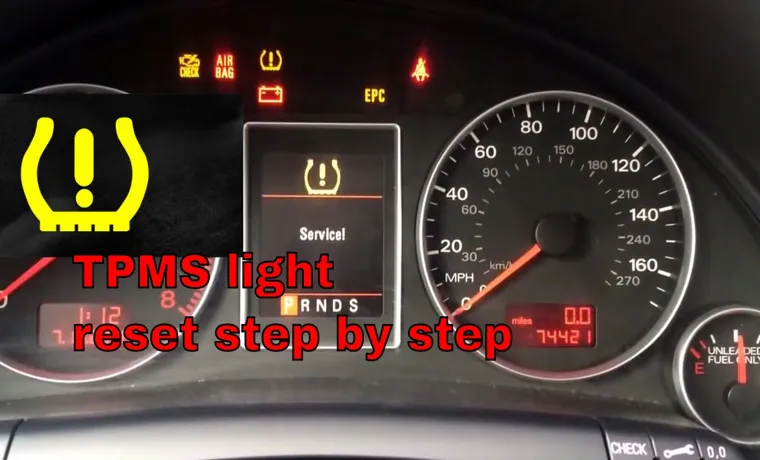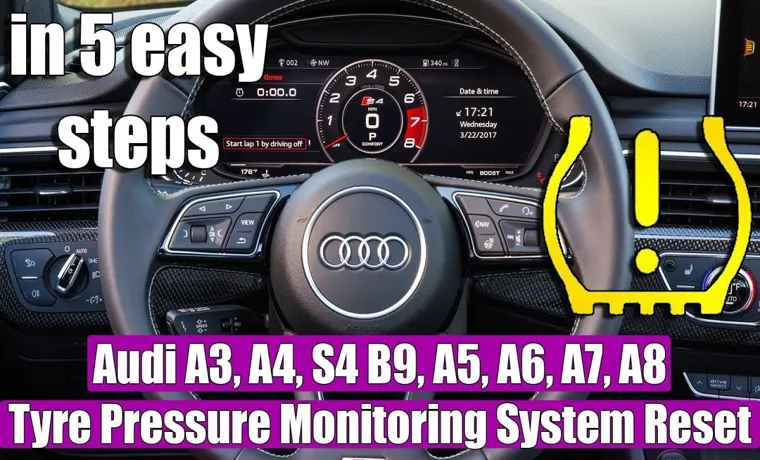Maintaining the tire pressure of your Audi A4 is an essential aspect of ensuring its smooth operation and keeping you safe on the road. Properly inflated tires will result in better fuel economy, better handling, and longer tire life. Additionally, tire pressure impacts your car’s overall performance, so it’s vital to regularly check and adjust your tire pressure.
In this blog post, we’ll show you how to check tire pressure on Audi A4 quickly, easily, and accurately. From using a tire pressure gauge to checking the recommended tire pressure for your Audi A4, we’ll cover all the necessary steps to ensure your tires are in pristine condition. So, read on to learn how to keep your Audi A4 running at its best with these simple tips.
Table of Contents
Why Checking Tire Pressure is Important
If you own an Audi A4, it’s important to regularly check your tire pressure. Keeping your tires properly inflated not only improves your car’s performance but also ensures your safety on the road. So, how do you check your Audi A4’s tire pressure? First, you’ll need a tire pressure gauge.
Simply remove the valve cap on your tire, press the gauge onto the valve stem, and read the number on the gauge. Compare this number to the recommended tire pressure listed in your owner’s manual. If the pressure is too low, add air until you reach the proper pressure.
If it’s too high, let some air out until you reach the recommended pressure. Checking your tire pressure may seem like a small task, but it can make a big difference in your car’s overall performance and safety.
Avoiding Accidents
Tire Pressure Keeping an eye on your tire pressure is of utmost importance when it comes to avoiding accidents. It may seem like a minor detail, but it can greatly affect your vehicle’s performance and safety on the road. When your tire pressure is too low, your tires become more susceptible to damage, such as a blowout or puncture.
This can lead to losing control of your vehicle, which can result in a crash. Moreover, driving with underinflated tires can also decrease your fuel efficiency, costing you more money in the long run. On the other hand, overinflated tires are equally dangerous, as they can cause your vehicle to bounce and result in a lack of traction, especially on wet roads.
Therefore, it is important to make a habit of checking your tire pressure regularly, at least once a month. This practice not only keeps you and your passengers safe but also helps extend the life of your tires. Remember to keep your tires inflated to the recommended pressure level, which you can find in your vehicle’s owner’s manual or on a tire placard on the driver’s side door jamb.
In conclusion, by taking a few minutes to check your tire pressure, you can avoid accidents, save money, and enjoy a more comfortable ride.

Saving Money
Saving Money When it comes to maintaining your car, checking the tire pressure is a crucial step that is often overlooked, especially when it comes to saving money. Low or overinflated tires can lead to decreased fuel efficiency, which can cost you a lot of money in the long run. Properly inflated tires not only save you money on gas, but they also reduce wear and tear on your tires, lowering the chance of having to replace them prematurely.
It’s recommended to check your tire pressure monthly or before long trips to ensure optimal inflation levels. As a metaphor, think of your tires like the soles of a shoe – if the soles are uneven, you’ll wear through them much faster, but with proper care and maintenance, you can keep them in good shape for a long time. So, taking care of your tires can help you save money on gas and replacement costs, while also ensuring a safer driving experience overall.
Improving Fuel Efficiency
Improving fuel efficiency is a smart choice for both the environment and your wallet. One simple way to boost your fuel economy is by checking your tire pressure regularly. Properly inflated tires can improve gas mileage by up to 3 percent, according to the U.
S. Department of Energy. This means that if you’re driving 12,000 miles per year, you could save up to 60 gallons of gas by keeping your tires at the right pressure.
Not only that, but properly inflated tires also last longer and are less prone to blowouts. So, what’s the right tire pressure? It varies by vehicle, but you can find the recommended pressure in your owner’s manual or on the sticker inside the driver’s door. Remember, even a few pounds of pressure under- or over-inflation can impact your fuel efficiency.
Give your tires a quick check every month and enjoy the benefits of better gas mileage and safer driving.
Steps to Check Tire Pressure on Audi A4
If you are wondering how to check tire pressure on an Audi A4, don’t worry, it’s a simple process that can be done in a few easy steps. First, identify the correct tire pressure for your vehicle. You can find this information in your owner’s manual, on the driver’s side door jamb, or in the glove box.
Once you have this information, remove the valve cap on the tire and place the tire pressure gauge onto the valve stem. The gauge will give you a reading of the tire pressure, which you can compare to the recommended pressure for your Audi A If the pressure is low, add air using a compressor or air pump until the tire reaches the correct pressure.
Be sure to check all four tires and adjust as necessary. Proper tire pressure is crucial for safety, fuel efficiency, and extending the life of your tires, so it’s important to check them regularly. By following these simple steps, you can ensure that your Audi A4’s tires are always in top condition.
Step 1: Locate Tire Pressure Information
If you happen to purchase a new or used Audi A4, one of the essential maintenance tasks you need to undertake is regularly checking your tire pressure. This step keeps you safe as well as prevents damage to your vehicle. To achieve proper tire pressure, you must first locate the tire pressure information.
This information is usually located in several key points, including the door panel, owner’s manual, or tire sidewall. Once you have located this information, you need to note the appropriate tire pressure for your vehicle and confirm it using a tire pressure gauge. Remember to check your tire pressure regularly to ensure optimal performance and safety while on the road.
So, when last did you check your tire pressure?
Step 2: Gather Necessary Tools
To check the tire pressure on your Audi A4, having the right tools on hand is crucial. You will need a tire pressure gauge, which can be purchased at most auto supply stores or online. It’s a small tool that you can carry in your glovebox, and it’s inexpensive.
Some gauges are digital, while others are analog, but either type will work just as well. You’ll also want to have a tire inflator or air compressor handy, in case you need to add air to your tires. These can be found at most gas stations or auto supply stores.
Having these tools ready to go will make the process much smoother and save you time and effort later on. So, before you get started, make sure you have everything you need on hand to check your Audi A4’s tire pressure accurately and effectively.
Step 3: Remove Valve Cap and Check Pressure
After finding the recommended tire pressure for your Audi A4 in the owner’s manual or on the driver’s side door panel, it’s time to remove the valve cap and check the pressure. This step requires a tire pressure gauge, which can be found at any auto parts store. Simply press the gauge onto the valve stem and the gauge will provide a reading of the tire pressure.
If the reading is within the recommended range, you’re good to go! If the reading is too low, you’ll need to add air until you reach the recommended pressure. Conversely, if the reading is too high, you’ll need to release some air until you reach the proper pressure. It’s important to repeat this process for each tire on your Audi A4 as they can vary in pressure.
Remember to put the valve caps back on securely to prevent air from leaking out and potentially causing a flat tire. By regularly checking and maintaining the correct tire pressure, you’ll improve your vehicle’s handling and fuel efficiency while extending the life of your tires.
Step 4: Inflate or Deflate If Needed
Once you’ve successfully measured the tire pressure on your Audi A4, it’s time to move on to the next step: inflating or deflating. Ideally, you want to have the recommended tire pressure and anything lower or greater needs attention. Have a look at your owner’s manual or at the tire pressure label, either inside the driver’s side door or in the glove box, for your vehicle’s recommended tire pressure.
If you have low tire pressure, you need to inflate the tire with an air compressor or an air pump. On the other hand, when you have too much air in the tire, use a tire gauge to release pressure until you meet the recommended PSI. This is not only important to keep the tires rolling smoothly, but it can also save you money on gas mileage.
Keep in mind that under and overinflated tires can result in uneven wear, which can lead to needing to replace tires more frequently. It’s better to stay on top of tire maintenance to avoid any unnecessary expenses.
Tips for Maintaining Proper Tire Pressure
Proper tire pressure is essential for safety and improved vehicle performance. While some Audi A4 models come equipped with tire pressure monitoring systems, it is still essential to check your tire pressure regularly manually. So, how can you check tire pressure on your Audi A4? First, you will need a reliable tire gauge, which can be purchased at your local auto supply store.
Ensure that you check tire pressure when the tires are cold, preferably in the morning before driving. To check the tire pressure, remove the valve cap and press the gauge onto the valve stem. The gauge will display the tire pressure reading, which should match the recommended pressure listed in your car’s user manual.
If the reading is below or higher than the recommended pressure, inflate or deflate the tires accordingly. Properly inflated tires not only ensure optimal vehicle safety, but they also improve fuel efficiency and reduce tire wear. So make sure to check your Audi’s tire pressure regularly and drive safely.
Check Tire Pressure Monthly
Checking your tire pressure regularly is an essential part of maintaining your vehicle’s safety and performance. Did you know that around one in three cars on the road are driving with underinflated tires? Not only can this reduce your fuel efficiency and increase wear on your tires, but it also puts you and other road users at risk of accidents. To ensure that you’re driving on tires with the correct pressure, it’s recommended that you check your tires at least once a month.
You can find the recommended pressure for your tires in your owner’s manual or on the tire placard located on the driver’s side door jamb. To check the pressure, use a tire pressure gauge and adjust it accordingly using an air compressor if needed. Proper tire pressure can help ensure a smoother ride, better handling, and longer tire life, saving you money in the long run.
So, take the time to check your tire pressure every month and stay safe on the road!
Avoid Over-Inflating or Under-Inflating Tires
Maintaining proper tire pressure is essential for ensuring optimal handling, performance, and fuel economy of your vehicle. Over-inflated tires can cause excessive wear and tear on the center treads, while under-inflated tires can lead to uneven wear and damage to the sidewalls. The recommended tire pressure for your car can be found in the owner’s manual or on the sticker inside the driver’s side door.
It’s important to check and adjust tire pressure regularly, at least once a month, or before any long road trip. An easy way to do this is by using a tire pressure gauge. Simply remove the valve cap, press the gauge onto the valve stem, and read the pressure.
If the tire pressure is too high, release air until it reaches the recommended level. Conversely, if the pressure is too low, add air until it meets the recommended level. Properly inflated tires improve fuel efficiency, reduce the risk of blowouts, and extend the life of your tires.
So, don’t forget to make tire maintenance a part of your regular vehicle maintenance routine.
Check Tire Pressure Before Long Trips
Tire pressure is one of the most important factors to consider when preparing for a long trip. It not only affects your car’s fuel efficiency but also the handling and overall safety. Keeping your tires inflated to the recommended pressure is crucial, especially when carrying heavy loads or driving on uneven terrain.
Plus, maintaining proper tire pressure prolongs the life of your tires, saving you money in the long run. To ensure that your tires are ready for the road, it’s a good idea to check the pressure before your trip. You can find the recommended tire pressure in your car manual or on the tire itself.
If the pressure is too low, add some air until you reach the recommended level. On the other hand, if it’s too high, release some air to avoid over-inflation. Remember, proper tire pressure is not something to be overlooked when getting ready for a road trip.
It’s a small but important task that can make a big difference in your safety and comfort on the road.
Conclusion
In the wise words of Shakespeare, a car’s tire pressure is oft overlooked, yet it doth make all the difference in a journey. To check the tire pressure on your Audi A4, first, find a reliable gauge and press it against the valve stem. Be sure to note the correct pressure for your vehicle, as getting it right can reduce wear and tear, improve fuel efficiency, and keep you safe on the road.
So, don’t let a flat tire be your tragic ending; keep those tires inflated and drive on, my friends.”
FAQs
What is the recommended tire pressure for Audi A4?
The recommended tire pressure for Audi A4 is usually mentioned in the owner’s manual and on a sticker located on the driver’s side door jamb. It is typically around 32 to 35 psi.
Is it necessary to check tire pressure on Audi A4 regularly?
Yes, it is important to check tire pressure on Audi A4 regularly, at least once a month, as it affects the car’s handling, fuel efficiency, and tire wear.
Can I use any tire pressure gauge to check tire pressure on my Audi A4?
You can use any tire pressure gauge that is calibrated properly and has a range suitable for the Audi A4’s recommended tire pressure.
How do I know if my Audi A4 tires are underinflated?
Symptoms of underinflated Audi A4 tires include decreased handling and stability, increased fuel consumption, and uneven tire wear.
What should I do if my Audi A4 tire pressure warning light comes on?
If the tire pressure warning light comes on in your Audi A4, you should check the tire pressure and inflate them if necessary. If the light continues to stay on, there may be other issues with the tire or tire pressure monitoring system that should be checked by a professional.
Can overinflated tires on my Audi A4 cause damage?
Overinflated tires on your Audi A4 can cause damage to the tire’s sidewall or even cause a blowout, which can be dangerous. Always check your Audi A4’s recommended tire pressure and do not exceed it.
How do I properly inflate the tires on my Audi A4?
To properly inflate the tires on your Audi A4, remove the valve cap, attach the tire pressure gauge, and inflate the tires to the recommended pressure. Be sure to check the pressure again after inflating to ensure it is correct.



